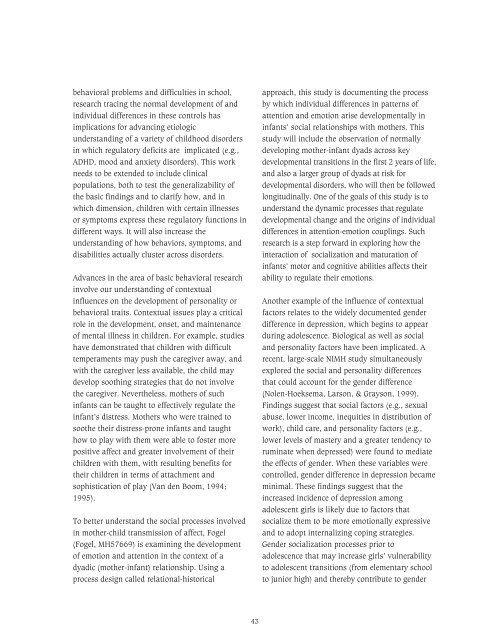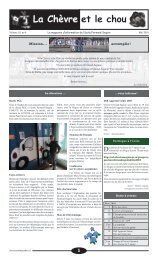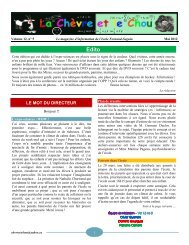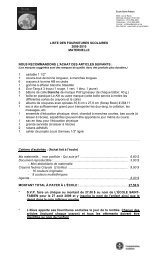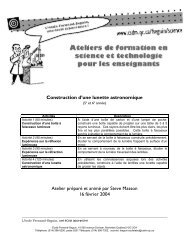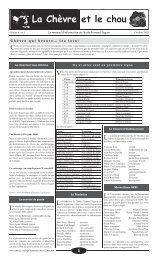Research on Child and Adolescent Mental Health
Research on Child and Adolescent Mental Health
Research on Child and Adolescent Mental Health
Create successful ePaper yourself
Turn your PDF publications into a flip-book with our unique Google optimized e-Paper software.
ehavioral problems <strong>and</strong> difficulties in school,<br />
research tracing the normal development of <strong>and</strong><br />
individual differences in these c<strong>on</strong>trols has<br />
implicati<strong>on</strong>s for advancing etiologic<br />
underst<strong>and</strong>ing of a variety of childhood disorders<br />
in which regulatory deficits are implicated (e.g.,<br />
ADHD, mood <strong>and</strong> anxiety disorders). This work<br />
needs to be extended to include clinical<br />
populati<strong>on</strong>s, both to test the generalizability of<br />
the basic findings <strong>and</strong> to clarify how, <strong>and</strong> in<br />
which dimensi<strong>on</strong>, children with certain illnesses<br />
or symptoms express these regulatory functi<strong>on</strong>s in<br />
different ways. It will also increase the<br />
underst<strong>and</strong>ing of how behaviors, symptoms, <strong>and</strong><br />
disabilities actually cluster across disorders.<br />
Advances in the area of basic behavioral research<br />
involve our underst<strong>and</strong>ing of c<strong>on</strong>textual<br />
influences <strong>on</strong> the development of pers<strong>on</strong>ality or<br />
behavioral traits. C<strong>on</strong>textual issues play a critical<br />
role in the development, <strong>on</strong>set, <strong>and</strong> maintenance<br />
of mental illness in children. For example, studies<br />
have dem<strong>on</strong>strated that children with difficult<br />
temperaments may push the caregiver away, <strong>and</strong><br />
with the caregiver less available, the child may<br />
develop soothing strategies that do not involve<br />
the caregiver. Nevertheless, mothers of such<br />
infants can be taught to effectively regulate the<br />
infant’s distress. Mothers who were trained to<br />
soothe their distress-pr<strong>on</strong>e infants <strong>and</strong> taught<br />
how to play with them were able to foster more<br />
positive affect <strong>and</strong> greater involvement of their<br />
children with them, with resulting benefits for<br />
their children in terms of attachment <strong>and</strong><br />
sophisticati<strong>on</strong> of play (Van den Boom, 1994;<br />
1995).<br />
To better underst<strong>and</strong> the social processes involved<br />
in mother-child transmissi<strong>on</strong> of affect, Fogel<br />
(Fogel, MH57669) is examining the development<br />
of emoti<strong>on</strong> <strong>and</strong> attenti<strong>on</strong> in the c<strong>on</strong>text of a<br />
dyadic (mother-infant) relati<strong>on</strong>ship. Using a<br />
process design called relati<strong>on</strong>al-historical<br />
approach, this study is documenting the process<br />
by which individual differences in patterns of<br />
attenti<strong>on</strong> <strong>and</strong> emoti<strong>on</strong> arise developmentally in<br />
infants’ social relati<strong>on</strong>ships with mothers. This<br />
study will include the observati<strong>on</strong> of normally<br />
developing mother-infant dyads across key<br />
developmental transiti<strong>on</strong>s in the first 2 years of life,<br />
<strong>and</strong> also a larger group of dyads at risk for<br />
developmental disorders, who will then be followed<br />
l<strong>on</strong>gitudinally. One of the goals of this study is to<br />
underst<strong>and</strong> the dynamic processes that regulate<br />
developmental change <strong>and</strong> the origins of individual<br />
differences in attenti<strong>on</strong>-emoti<strong>on</strong> couplings. Such<br />
research is a step forward in exploring how the<br />
interacti<strong>on</strong> of socializati<strong>on</strong> <strong>and</strong> maturati<strong>on</strong> of<br />
infants’ motor <strong>and</strong> cognitive abilities affects their<br />
ability to regulate their emoti<strong>on</strong>s.<br />
Another example of the influence of c<strong>on</strong>textual<br />
factors relates to the widely documented gender<br />
difference in depressi<strong>on</strong>, which begins to appear<br />
during adolescence. Biological as well as social<br />
<strong>and</strong> pers<strong>on</strong>ality factors have been implicated. A<br />
recent, large-scale NIMH study simultaneously<br />
explored the social <strong>and</strong> pers<strong>on</strong>ality differences<br />
that could account for the gender difference<br />
(Nolen-Hoeksema, Lars<strong>on</strong>, & Grays<strong>on</strong>, 1999).<br />
Findings suggest that social factors (e.g., sexual<br />
abuse, lower income, inequities in distributi<strong>on</strong> of<br />
work), child care, <strong>and</strong> pers<strong>on</strong>ality factors (e.g.,<br />
lower levels of mastery <strong>and</strong> a greater tendency to<br />
ruminate when depressed) were found to mediate<br />
the effects of gender. When these variables were<br />
c<strong>on</strong>trolled, gender difference in depressi<strong>on</strong> became<br />
minimal. These findings suggest that the<br />
increased incidence of depressi<strong>on</strong> am<strong>on</strong>g<br />
adolescent girls is likely due to factors that<br />
socialize them to be more emoti<strong>on</strong>ally expressive<br />
<strong>and</strong> to adopt internalizing coping strategies.<br />
Gender socializati<strong>on</strong> processes prior to<br />
adolescence that may increase girls’ vulnerability<br />
to adolescent transiti<strong>on</strong>s (from elementary school<br />
to junior high) <strong>and</strong> thereby c<strong>on</strong>tribute to gender<br />
43


